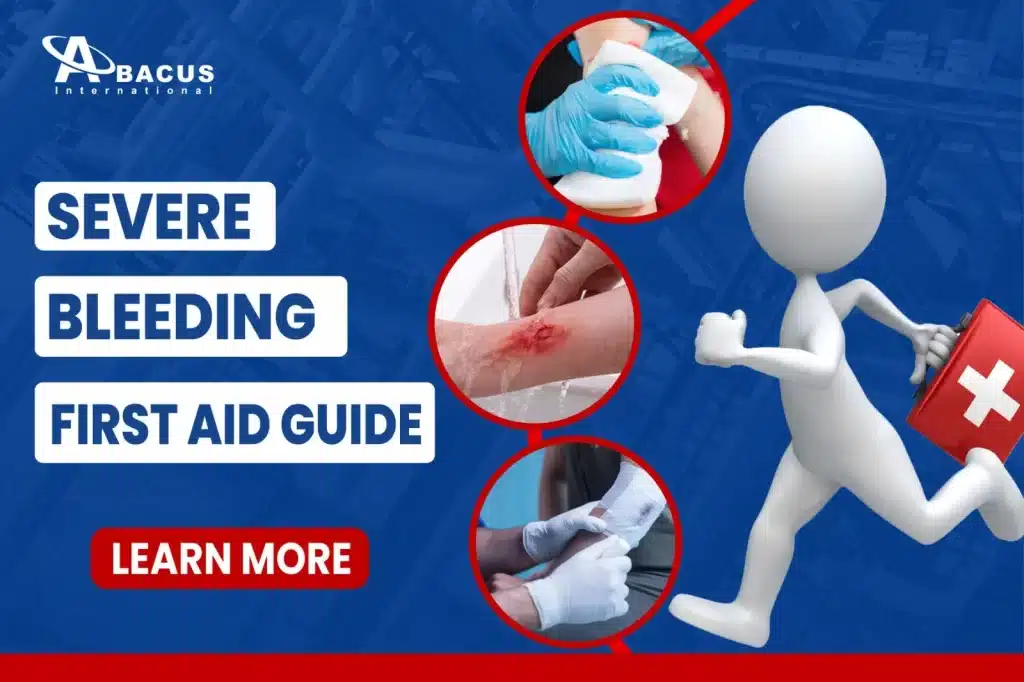Severe bleeding can be life threatening if not managed quickly. It may occur due to deep cuts, puncture wounds, or traumatic injuries. That is why it is necessary to understand how to give a first aid to stop severe bleeding before the arrival of any professional medical assistance.
Bleeding occurs when any blood vessel is damaged due to an injury. The severity of bleeding depends on the type of blood vessel affected.
Types of Bleeding
- Arterial Bleeding – This is the most dangerous type of bleeding. Bright red, spurting blood from an artery due to high pressure.
- Venous Bleeding – Dark red blood that flows steadily. It can still be life-threatening if not controlled.
- Capillary Bleeding – Slow oozing from small blood vessels It is usually not life-threatening but should still be treated.
Signs and Symptoms of Severe Bleeding
- Heavy, uncontrolled bleeding from a wound
- Rapid blood loss
- Dizziness or fainting
- Pale, cold or clammy skin
- Weak pulse or rapid breathing
First Aid Steps for Severe Bleeding
Follow these steps to control severe bleeding:
Step 1: Call for Emergency Help
- Dial emergency services of your local area.
- Provide them clear details about the injury.
Step 2: Apply Direct Pressure
- Use a clean cloth or sterile bandage.
- Press firmly on the wound to slow bleeding.
Step 3: Lift the Injured Area
- Raise the wounded limb above heart level (if possible).
- This helps reduce blood flow and pressure.
Step 4: Use a Clean Dressing or Cloth
- Keep applying pressure with a sterile bandage.
- Do not remove the first bandage if blood soaks through; instead, add another layer.
Step 5: Apply a Tourniquet (If Necessary)
- Use only if bleeding is uncontrollable.
- Place the tourniquet 2 inches above the wound.
- Tighten until bleeding stops but avoid excessive pressure.
Special Considerations for Severe Bleeding
1. Severe Bleeding from the Head or Face
- Do not apply direct pressure to a bleeding head wound if a skull fracture is suspected.
- Keep the victim in a sitting position if possible.
2. First Aid for Nosebleeds and Mouth Bleeding
- Pinch the nose for 10-15 minutes and lean forward.
- For mouth bleeding, have the person rinse with cold water.
3. Internal Bleeding Warning Signs
If you suspect internal bleeding (e.g., from a car crash or fall), look for signs like:
- Bruising, swelling, or pain without an external wound.
- Vomiting blood or blood in urine.

4. When to Remove or Change a Dressing
- If the dressing is soaked, apply another layer without removing the first.
- If bleeding stops, replace with a clean bandage.
5. When to Seek Medical Help After First Aid
- If bleeding does not stop within 10 minutes.
- If the wound is deep or caused by a dirty object.
Frequently Asked Questions (FAQs)
1. Should I remove an object embedded in the wound?

Why Not?
- The object may be blocking the bleeding, and removing it could cause uncontrollable hemorrhage.
- The object might have pierced a major artery or vein, and pulling it out could worsen the damage.
- The wound could be larger or deeper than it looks, and medical professionals need to assess it properly.
What to Do Instead?
- Stabilize the object
- Do not try to move or twist the object.
- Use rolled gauze, cloth, or padding around the object to hold it in place.
- Control bleeding around it
- Apply gentle pressure around (not on) the object to slow blood loss.
- If possible, elevate the injured area.
- Seek emergency medical help immediately
- Call 911 or take the person to a hospital for professional treatment.

2. What should I do if I don’t have a clean cloth for pressure?
If you don’t have a clean cloth or bandage to apply pressure to a bleeding wound, you should use whatever is available to stop the bleeding. The priority is to control blood loss immediately rather than wait for sterile materials.
Alternatives You Can Use:
- Your bare hands: If nothing else is available, wash your hands if possible and press firmly on the wound with your palms or fingers.
- A piece of clothing: Use a shirt, scarf, or any fabric as a makeshift bandage. Ideally, choose a clean part of the fabric, but even a non-sterile material is better than letting the person lose excessive blood.
- Plastic bag or waterproof material: In cases where no cloth is available, using a clean plastic bag or food wrap can help seal the wound and slow bleeding.



